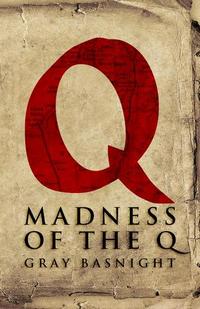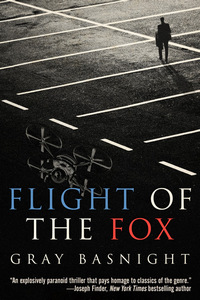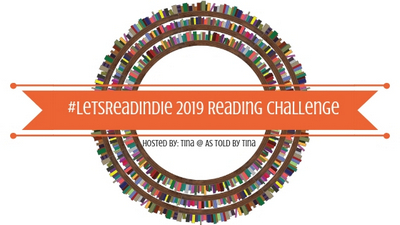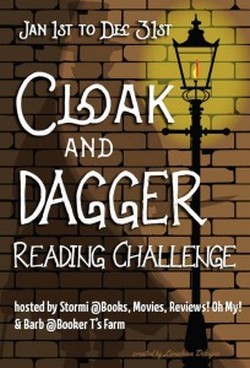Not only do I really appreciate Basnight’s taking the time to do this, but Lisa Weiss, the publicist who got me this book has been very helpful and encouraging. I wanted to thank her, too. This is one of the best sets of Answers I’ve received to my Questions, I hope you enjoy it, too.
The last time we did a Q&A, you said you were finishing a sequel to Flight of the Fox, I assume it was this, what was it about Sam Teagarden that made you want to write a sequel about him (an idea that Sam himself jokes about)? Is there a third book for the professor?
There are two reasons Sam Teagarden puts in this reappearance in Madness of the Q. The first was reader feedback. In fact, this sequel is dedicated to those readers who wanted another roller coaster ride with my mathematics professor, who’s dubbed by the media as the “American Prometheus.”
The second reason is the Q Document. The inspiration for the story came several years ago while listening to a Great Courses audio lecture about the New Testament. When the professor casually mentioned something called the Quelle Document (German for “Source”) as being a theorized long missing source for parts of Matthew and Luke, I pegged onto it as a potential “what if” fictional scenario. What if The Quelle Document were discovered in our time. And an even bigger “what if’ — what if the document said something from the founding days of Christianity that certain groups didn’t want it to say, and what if it said something that certain opposing groups did want it to say? Well, my guess is that all hell would break loose. So, in Madness of the Q, it does – fictionally, of course!
As for a third book, we shall see. If there’s sufficient demand from readers and/or the publisher, I’ll certainly consider it. I do have a nascent idea. All I will say is, I like Puerto Rico and perhaps there’s a reason for Teagarden to end up there. It’s a wonderful and adventurous island filled with good people, good food, and plenty of potential for a fictional thriller.
What kind of research went into this book? What’s the one thing you learned and, try as you might, you just couldn’t bring into the book?
Once I learned about the Q Document, I began reading up on the theory that it might actually have existed but was lost, and may someday be found. Not all biblical scholars agree, of course. But those who believe that it is an extant missing source for two of the Synoptic Gospels are both faith based and secular based, which intrigued me.
I also re-read a wonderful book first published in 1841 and still in print today. Extraordinary Popular Delusions and the Madness of Crowds by Charles Mackay is occasionally called the first pop-psych book to explore crowd think. It dovetailed nicely with my “all hell breaks loose” theme, so I wove it into the title and quoted Mackay as the epigraph:
Men, it has been well said, think in herds;
it will be seen that they go mad in herds,
while they recover their senses slowly,
and one by one.
As for what was left on the cutting room floor, I felt a need to have Teagarden’s spouse Cynthia, be more of a partner. They met in Flight of the Fox and she became an important ally in many ways. Unfortunately, she couldn’t join him in the sequel because he’s on a solo run through Israel and Europe and there was no way around that. Thus, I invented imaginary conversations between the two to help him get through the roughest days, and justified the technique as a product of his stress. Thus far, most reader feedback has been positive with this approach.
I think most of us readers can guess some of these, but would you talk about the challenges in featuring someone of Teagarden’s age in a thriller (particularly those you didn’t expect)?
You mean the fact that he’s older than the average thriller protagonist? Yes, indeed. He turned 50 in Flight of the Fox which makes him 56 in Madness of the Q.
The principal challenge is to convince the reader that someone of that age is still sufficiently vigorous to take on dark forces. This is important to me. The older I get, the more convinced I am of an age bias built into American culture and our collective way of thinking (to which I was admittedly guilty of in my younger years).
Sam is however highly qualified for the job in both thrillers. His first gig out of college was a desk job at the CIA as an entry-level code analyst. It was so boring he quit after one year. He then became a mathematics professor who is highly skilled in the art of encryption and decryption.
Aside from his age, Teagarden does not have a black belt and knows very little about firearms. So, both his age and his lack of fighting skills may challenge a reader’s expectation of the formulaic run-for-your-life character.
I intentionally made all these choices to construct a character far less Jason Bourne and more of an Everyman. If readers are unbothered by his age, I’ve succeeded. If readers who are a little bothered by his age but stick with the narrative because the momentum carries them to its conclusion, I’ve still succeeded.
There’s a time jump between the two books, putting this one into our near future. How fun was it speculating about 2025 tech—and how hard was it not to go too crazy with it?
It was great fun. I have no desire to be a sci-fi writer, so there was no difficulty in not getting carried away. But I really enjoy casting into the near-term future and imagining where foreseeable technology is going based on where it has been.
For example, God Glasses. In the story, God Glasses allow a type of Superman x-ray vision. That may not happen anytime soon, but we already have the technology for video cameras to be built into eyeglass frames.
Another is public pop-ups. Web based pop-up ads annoy me, umm, a whole lot. It happens because neither the advertiser nor the website proprietor cares about the irritation factor – and for plenty of people, it’s an exasperating reality but one they mostly just accept. Given that, let’s get ready for the same to happen in public. In the novel, Sam Teagarden and his wife have researched airfare to the Bahamas. Later, when he’s on a public sidewalk, the wi-fi gear attached to a giant billboard reads the credit card in his wallet and suddenly Sam’s image and name appear on the billboard as the advertiser stalks his movements in the effort to sell him a trip to the Bahamas. If this ever happens in reality, pro-privacy forces will naturally object. I’m certain, however, they’ll lose that fight because the vast majority of people will find it really cool to see their mug on a billboard, even if only for a few seconds.
Let’s play “Online Bookstore Algorithm” (a game I’ve recently invented). What are 3-5 books whose readers may like Madness of the Q?
Well, I’m going to share the books mentioned by several of the early reviewers, and the ones that inspired me to try my hand at thrillers:
- Robert Ludlum’s Bourne series
- Dan Brown’s Langdon series
- Eye of the Needle and The Key to Rebecca, by Ken Follett
- Name of the Rose, by Umberto Eco
And I’d be remiss for not giving a humble plug to the prequel:
- Flight of the Fox, by Gray Basnight (that’s me!)
What’s next for Gray Basnight? Any progress on that YA novel you mentioned before?
Thank you so much for asking about my YA! I love it and remain committed to its commercial prospects. Authoritative persons have recently advised me that it likely fits more neatly into Middle Grade, which means substantial rewriting, including the need to adjust the age of Junior Benét, the central character – a schoolgirl with a genius IQ who gets caught up in a dangerous adventure in New York City.
Presently I’m working on a crime novel, though I’m not sure how to classify it with more specificity. It’s drawn from my appreciation of both Quentin Tarantino and Elmore Leonard and my love for the classic Sergio Leone movie The Good, the Bad, and the Ugly. When finished, it will likely have emphatic elements of humor and romance. And, by the way, it too is set about five years into the future.
Thanks for your time — and thanks for some more time with Sam Teagarden, I really enjoyed it, and hope you have plenty of success with it.
Thank you so much for this Q&A. Great questions and lots of fun to spend time with you again.









